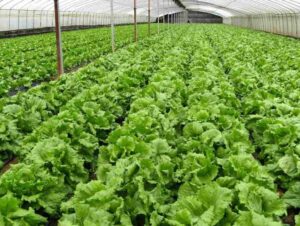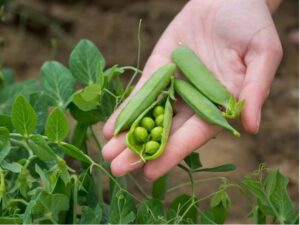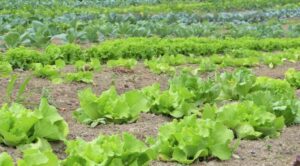Organic Farming Business 2023: Organic farming is growing crops without the use of artificial pesticides or other chemicals. For the purpose of fertilizing the land, this method of farming uses manure, animal waste produced by animal husbandry, goat manure, manure, green manure, etc. There are no negative effects on the environment or human health while employing organic systems.
The primary goal of organic farming in India is to establish environmentally responsible businesses. Crop rotations, the use of crop residues, animal manures, legumes, green manures, bio-fertilizers, mechanical cultivation, and some biological control techniques are all used in organic systems to maintain soil productivity and control insects, weeds, and other pests. Farmers, managers, academics, decision-makers, and of course customers are all becoming more interested in the development of organic farming in the nation. Most people believe that organic food products are healthier and safer than those made by conventional farming. Additionally, organic farming contributes to soil health restoration, environmental protection, biodiversity enhancement, crop productivity sustainability, and increased farmer income. We also discussed the following issues with organic farming in India in this article:
- What are organic farming and its main benefits
- Is organic farming profitable in India
- Complete guide on how to start organic farming
- Things you need to know when starting an organic farm business
- Importance of organic farming
- Is organic farming a profitable business

In India, organic farming is an agrarian technique that focuses primarily on using organic food sources and reducing the amount of synthetic chemicals. This includes not using growth hormones in any way, which reduces soil corruption and contamination. In India, organic farming is becoming more and more prevalent. The main techniques used in organic farming include crop rotation, biological pest management, green manures and compost, and mechanical cultivation.
What Is Organic Farming in India?
When crops are grown organically, growth regulators, synthetic fertilizers, and pesticides are often avoided. Through the use of organic wastes, which release crop nutrients for greater output, it strives to cultivate the soil and promote good health.
The reason behind the organic farming business growth is;
- Its benefit to health, and benefit to the environment,
- Improved agricultural cycle,
- Reduced imports of pesticides and other foreign fertilizers and
- Increased employment generation
Promoting Organic Farming in India
The use of synthetic inputs is primarily prohibited in organic farming, which relies instead on crop rotation, crop wastes, animal manures, and a biological system for nutrient mobilization and plant protection. Following production, the food we eat is healthier and is then completely fresh and natural.
The organic products certification is based on the below principles:
There must be established norms for organic production and processing.
It is necessary to certify that these stands were produced.
Only products proven to comply with the established requirements may bear the organic label.
Plants are grown using just natural components, devoid of any synthetic inputs, in organic farming. Compared to mass manufacturing utilizing artificial additives, organic farming produces healthier produce, and customers contend that organic food actually tastes better because bio-based components are used in its manufacture. Avoiding synthetic materials helps prevent pollution while preserving the delicate ecological balance of grassland ecosystems and soil fertility.
Madhya Pradesh, Rajasthan, and Maharashtra are the top 3 states where there are several subscribers to organic farming. Madhya Pradesh tops under organic farming with 0.76 million hectares of cultivable farmland.
Key Characteristics of Organic Farming
The key characteristics of organic farming include
- By promoting soil biological activity, preserving organic matter levels, and taking care with mechanical intervention, long-term soil fertility can be preserved.
- Employing insoluble sources of nutrients that are made available to plants by soil microorganisms to provide crop nutrients indirectly.
- Legumes and adequate recycling of organic materials, such as crop leftovers, can help to produce enough nitrogen on their own.
- Crop rotation, organic manuring, some resistant types, and chemical intervention are the main methods used to control weeds, diseases, and pests.
- The significant livestock management, as well as certain concerns for animal welfare regarding housing, feeding, and health
- Additionally, pay close attention to how the system affects the larger world.
Benefits of Organic Agriculture

- By lowering pollutant levels, organic farming contributes to the preservation of environmental health.
- It reduces human and animal health hazards by reducing the residues level in the product.
- Compared to conventional farming, organic crops are more superior in terms of structure and metabolism.
- Compared to conventional farming, organic farming has much lower input costs.
- Plants that are grown organically are better able to withstand drought and can even flourish in locations without proper watering systems.
- Through scientific crop rotation and other techniques, plant diseases, weeds, and pests are naturally rejected or discouraged in organic farming.
- The same plot of land produces more crops.
- Income security and rich returns on investment are assured.
- Crops grown organically are less susceptible to drought and rainy conditions.
- Natural crop rotation used in organic farming deters plant diseases, weeds, and pests.
- Soil health is enhanced through organic farming.
- Organic farming improves soil properties and improves water-holding capacity.
- It enhances the soil’s chemical properties, including nutrient supply and retention, nutrient loss into the environment and water bodies, and the promotion of advantageous chemical interactions.
Tips for Soil Preparation for Organic Farming
Increased soil nutrients are the goal of organic farming. Good crop yields must be guaranteed by effective management of the soil’s nutrients, structure, and biological. Organic systems are primarily supported by healthy soil. In addition to supporting an active biotic community that aids in the soil’s resistance to environmental degradation, fertile soil will supply critical plant nutrients.
The organic farming approach is far more challenging than conventional farming since you must prepare the land and create your own natural fertilizers and insecticides.
The following are the most important considerations for soil preparation:
1.Utilize nutrient-rich compost and cow manure to improve the soil (buy this kit to produce your own compost).
2. Following crop planting, keep an eye out for weeds and pests. It is difficult to recover once the infestation has occurred.
3. Daily maintenance is essential. using natural fertilizers and cow dung solution to water, etc.
4.To keep pests out of crops, hang yellow or blue boards that have been covered in castor oil.
5.Choose plants like tomatoes, beans, and climbers that require less water and more sunlight.
6. Give priority to plants that can become encroached upon in loose soil.
Soil management is the main organic agricultural technique in India. Soil loses nutrients and its fertilizer after the farming process. A soil management system is the process by which soil is replenished with all necessary nutrients. It raises soil fertility using organic techniques. It makes use of microorganisms found in animal manure, and these bacteria assist the soil become more fruitful and productive.
The key components of organic farming practices—crop rotation, intercropping, symbiotic relationships, cover crops, organic fertilizers, and minimal tillage—are those that develop soil. Such management techniques are crucial for preventing soil erosion.
Steps for How to Start Organic Farming in India

Follow the steps listed below to start organic farming:
Step 1: Get Organic Certification
One of the crucial elements in beginning an organic farm is getting the certification. If you do not already own land, you may always lease land or, if your budget allows it, buy it to practice organic farming.
The following list includes the goals for obtaining organic certification:
1.Organic farming started to export the produce to other companies.
2. Organic farming started to cater to the domestic need for organic produce.
Step 2: Selecting Site for Organic Farming
Any business venture’s success is heavily influenced by its location. The success of any organic farming venture in India depends on the region. Since pure water is the most essential resource for crop growth and health, the organic farming location should be adjacent to a source of it.
It is far more difficult to manage irrigation practices in organic farming if your water supply is far away. This may seem like a boring concept to have as an initiation, yet it is vital for productive labor on your farm. The proximity of the organic farming region to the business district enhances the farm’s ability to be managed. The proximity of the organic farm to the market allows for simple marketing communication. Additionally, it saves money on sending supplies to the farm.
Any venture that wants to succeed must have a successful website. The location of an organic farm affects how the business operates. Make sure the farm’s proximity to the market enables simple transportation of goods for sale. Additionally, this primarily lowers the cost of delivering goods to the farm. The importance of the aforementioned variables may reduce if the organic farm is not being used for commercial purposes, and the size of the organic farm is also determined by its function.
Step 3: Prepare the soil and make good compost
Most people believe soil to be the organic farmer’s fundamental building block. Everything, starting with its appearance, wellbeing, and equalization, is in charge of the producing outcome. Therefore, it basically becomes crucial to understand when and how to improve your soil and create the best environment for harvests to persist and flourish.
To give your plants the necessary nutrients to flourish healthily, organic farming requires good soils. A healthy soil environment is the foundation for all wonderful organic farm produce. Inorganic soil treatments run the risk of harming the ecosystem, the crops that are grown there, and the people who will eventually consume the food. Compost, grass and leaf clippings, manure, and other essential components are all mixed together to make good soil. In general, farmers gain by making their compost on-site. It is really simple to manufacture and is very cost-effective. Main benefits of compost include weed control, trash containment, and water conservation. When starting organic farming, this stage is essential.
Step 4: Select a suitable crop
Only a small number of crops can be grown organically, doing so provides lower yields, and managing pests and diseases without chemical spray is challenging. Any crop can be grown organically as well. However, it is always suggested to cultivate the crop according to the location, the soil, and the surrounding environment. Observe what other farmers are growing as you look around. Keep track of market pricing frequently and select the product that will bring in a good price and allow you to make a profit at the end of the season.
To choose the best product, it is crucial to be aware of the local weather patterns and the crops that can flourish there. A number of important things must be taken into account before making this choice. which are
- The health and quality of the crop are determined by the soil’s pH, alkalinity, water retention, nutrient content, and porosity levels.
- the local market’s need
- Composition and availability of water
- Needed organic inputs, their price, and accessibility
- the required tools and their accessibility
Step 5: Start looking for Markets
You will be in serious difficulty if you raise organic crops on your farm and do not know where to sell them once they are harvested. Not all distributors require crops cultivated organically. As a result, before starting an organic farming operation, you need to identify your target market. What market will you offer your organic goods in? It will be simple for you to sell the product after harvesting if you have any kind of thought in this regard.
Step 6: Take care of what you plant
Compared to conventional farming, organic farming requires more effort and care. Depending on the plant and farm conditions, specific approaches must be taken into account. Furthermore, not all of the farm’s plants may respond well to organic farming.
Step 7: Water Management for Organic Farming
Water is necessary for healthy plant growth. Regular irrigation is required for crop growth. Depending on the type, plants need to be watered 2 to 3 times per day. Because mornings are chilly, watering the plant in the morning is beneficial. Another crucial upkeep duty in organic gardening is weeding.
The fundamental issue in many agricultural areas is synthetic fertilizer and pesticide pollution of groundwater systems. Through the use of more diverse cultivable species, they are replaced by organic fertilizers. Improved nutrient retention capabilities in organic systems under good management can lessen the likelihood of groundwater pollution. In some regions where pollution is a serious issue, switching to organic farming is strongly advocated as a remedial approach.
Organic Farming Practices in India
The idea of organic agriculture necessitates some practical techniques. The following practices are examples of the typical and accepted ones:
Crop Rotation: Seasonally varying species on the same field is what it signifies. A fallow season may also be a part of this agriculture within a specific time frame. Crop rotation will in comparison to monoculture agricultural approaches.
- Additionally, with various root systems, avoids soil erosion.
- prevents soil evaporation, avoiding the need for synthetic fertilizer applications that are prohibited in organic farming
- increases yields and lowers costs.
Cover Cropping: This refers to partially or totally covering the field with any plant species during a specific growing season in between the crop rows. With their roots, cover crops combat soil erosion and aeration while also enhancing water filtration. Additionally, they do away with upper-level weeding by shielding undesirable vegetation from sunlight.
Green Fertilizers: The soil is enriched with organic materials, particularly nitrogen, when green plants are added to it. Additionally, it raises moisture levels and offers nutrients for microorganisms, enhancing the quality of the soil. Agriculture practices also lessen weed invasion.
The method is constrained since the substance does not have any artificial additions, the soil must be examined before applications, and manures can be used for at least three months before harvest. Composted forms are preferred because they are more volumetrically compact and contain fewer germs and pollutants.
Integrated Weed Management
Organic farming is not allowed to use powerful chemicals. Because of this, integrated weed management techniques like preventative, biological, physical, and cultural weed management are used to control weeds:
1. Avoiding weed penetration onto the field with machinery, and irrigation
2. waters
3. Manual weeding
4. Crop rotation
5.Mulching
6. Natural chemicals to stop germination
7. Haymaking before weed seeding
8. Introducing populations of birds or insects to consume weed seeds, etc.
Organic Farming Startup Costs in India
You require loans to launch any new agriculture enterprise. Many sectors experience trouble getting a loan. not in organic farming, though. The early establishment expenditures are covered by loans from nationalized banks. Farmers can easily apply for loans from the State Bank of India provided they have at least 5 acres of land or a certification in organic farming.
Some typical features of these loans are
- Minimum 3-year term.
- A loan of around Rs. 1 lakh can be approved with a minimum of 5 acres of land. 40% of this goes for organic inputs, with the remaining funds going toward training.
- The farmer may receive a subsidy up to a maximum of 20%.
- The Indian Central Government will offer subsidies that lessen the cost of borrowing. As a result, financing organic farming becomes appealing.
Management of Nutrients in Organic Agriculture
Nutrient management is crucial in organic farming to continuously work to develop healthy soil that is rich in organic matter and contains all the nutrients the plants require. To increase soil fertility, a variety of techniques can be utilized, including green manuring, the addition of manures and biofertilizers, etc. These organic sources not only enrich the soil with various nutrients, but also aid in weed control and increase the amount of organic matter available to soil microbes. High organic matter soil is less prone to erosion, retains water better, and requires less irrigation. Additionally, some natural minerals that the crops require to flourish and enhance the consistency of the soil can be supplied. To change the pH of the soil, amendments are added. However, there should be a minimum amount of heavy metals in water and soil amendment. Numerous organic fertilizers are made from recycled waste by-products from different industries. Additionally, producers create compost using mushroom compost and animal manures. For crop growth in organic farming, some organic fertilizers as well as bacterial and fungal biofertilizers can be utilized.
Different Types of Organic Manures
Fish manure, oilcake, blood meal, and other organic manures are utilized in conventional farming. They are additionally known as organic nitrogen fertilizers. Bacterial action transforms their organic nitrogen into readily available ammonia and nitrogen before it is utilised by the plants.
Green Manure: Green fertilizer primarily promotes a superior soil structure and soil richness. They will offer organic matter and an extra dose of nitrogen, especially if you plan to grow vegetables.
Compost: Reducing the Carbon: Nitrogen ratio can sometimes cause new deposits from farm and household leftovers to build, get saturated, and eventually transform into aerated deposits.
The residues listed below can be used as organic manure:
- Crop straws
- Crop residues
- Leaves
- Bagasse
- Groundnut husk
- Paddy husk
- Sugarcane trash
- Cattle dung and urine
- Kitchen and vegetable wastes
- Household garbage (biodegradable)
Management of Pests and Diseases in Organic Agriculture
In organic farming, the presence of pests is predicted beforehand, and planting schedules and places are altered as much as possible based on the pest presence to minimize significant pest problems. Building up a population of helpful insects, whose larvae eat off the eggs of pests, is the main tactic used to tackle dangerous pests. The host crops act as their home base and gradually draw more beneficial insects, which are then regularly released. The use of natural or ecologically approved insecticides, such as neem pesticides, is done when faced with a pest infestation that cannot be controlled by beneficial insects. Low toxicity and low environmental persistence are key requirements for approved organic insecticides. The National Organic Standards largely dictate these requirements.
In organic and minimal input production systems, a number of diseases have a significant negative impact on crop output and quality. Additionally, it has been demonstrated that good fertility management of crops, including the use of crop rotation and a balanced supply of macro- and micronutrients, increases the resilience of crops to specific diseases. Soil that is healthy and teeming with helpful organisms is one of the main benefits of organic farming. These beneficial bacteria, fungus, and microorganisms will keep the disease-causing bacteria and fungi in check.
Organic insecticides come from sources that are found in nature. Among them are both biological things, such as the bacterium Bacillus Thuringiensis, and plant products, such pyrethrins or neem oil. Sulfur and copper-based inorganic insecticides are also permitted.
Utilizing parasitoids, such as certain wasps, or predatory insects, such as ladybugs, to combat insect pests is known as biological control. Last but not least, conventional plant breeding has resulted in a variety of crop cultivars that are resistant to particular pests. Genetic protection against pests and a number of plant diseases is provided by the use of such types and the planting of genetically diverse crops.
Government Schemes for Promoting Organic Farming
The Indian government provides financial aid to organic farmers. It is primarily provided by the National Center of Organic Farming (NCOF), which is part of the Department of Agriculture and works with NABARD. The major goal is to quickly make organic resources available for enhancing farm productivity while preventing the degradation of ecosystem balance and soil health. To encourage the transformation of organic wastes into plant food sources, incentives are given for minimizing reliance on chemical assistance. For organic producers, there are back-ended and credit-linked incentives available.
The subsidy for biological fertilizer and pesticide units is roughly 25% of the net project cost, with a cap of INR 40 lakhs per unit. Through various initiatives and programs including the National Mission for Sustainable Agriculture (NMSA)/Paramparagat Krishi Vikas Yojana (PKVY), Rashtriya Krishi Vikas Yojana (RKVY), and Network Project on Organic Farming of the ICAR, the Indian government is encouraging organic farming. The Ministry of Agriculture and Farmers Welfare is a division of the NMSA (National Mission for Sustainable Agriculture), which promotes organic farming. The scheme primarily offers financial support for the establishment of composting facilities for agricultural wastes, mechanized fruit and vegetable market wastes, and production facilities for liquid carrier-based biofertilizers and biopesticides.
Different Schemes for Promoting Organic Farming
The Indian Government provides support for promoting organic farming across the country through different schemes.
Paramparagat Krishi Vikas Yojana (PKVY) – It promotes cluster-based organic farming with Participatory Guarantee System certification. Under this scheme, cluster formation, training, certification, and marketing are supported. For organic farm inputs, the assistance of Rs. 50,000 per hectare /3 years is provided out of which 62% about Rs. 31,000 is given as an incentive to an organic farmer.
MOVCDNER (Mission Organic Value Chain Development for North Eastern Region) – The scheme promotes 3rd party certified organic farming of niche crops of the northeast region through Farmer Producer Organizations (FPOs) with a focus on exports. Farmers are given the assistance of Rs 25,000 per hectare for 3 years for organic inputs.
CISS (Capital Investment Subsidy Scheme) under SHM (Soil Health Management) – Under this scheme, agro waste compost farming units up to a limit of about Rs 190 lakh per unit 100% assistance is provided to the state government. It assists up to 33% of the cost limit to Rs 63 lakh per unit for private agencies and individuals as capital investment is provided.
National Mission on Oilseeds and Oil Palm (NMOOP) – Under NMOOP, financial assistance at a 50% subsidy of Rs. 300 per hectare is provided for different components, Zinc Solubilizing Bacteria (ZSB), Phosphate Solubilizing Bacteria (PSB), Mycorrhiza, and vermicomposting.
National Food Security Mission (NFSM) – In organic farming, the NFSM scheme provides financial assistance for the promotion of bio-fertilizer.
Profitability of Organic Farming in India
If the right market can be reached, organic farming can be a lucrative endeavor. Profits rise in two ways.
- Organic waste can be used as bio-fertilizer to lower the cost of farm input by employing crop and animal residue.
- When compared to farms that cultivate conventional crops, the market value and demand for organic products are considerable.
Investment Required for Organic Farming Business
Investment Necessary for Organic Farming Enterprise
An investment of between 5 and 10 lakhs is needed to launch an organic farming enterprise.
Government assistance available:
- The National Center for Organic Agriculture under NABARD provides capital investment subsidies.
- For biological fertilizers and pesticides, there is a 25% subsidy (up to a maximum of Rs. 40 lakh per unit).
- Fruit and vegetable subsidies of 33% with a maximum of 60 lakhs per unit.
- Organic farming is given access to credit-linked and back-ended subsidies.
Constraints Being Faced in Organic Farming
Organic farming, while gaining popularity and recognition for its environmental and health benefits, also faces various constraints and challenges. Some of the key constraints faced in organic farming include:
- Transition Period: When conventional farms decide to switch to organic farming practices, they must go through a transition period where they eliminate the use of synthetic pesticides, fertilizers, and genetically modified organisms (GMOs). This transition period typically takes several years and can be financially challenging for farmers as they may experience lower yields during this phase.
- Limited Availability of Organic Inputs: Organic farmers rely on organic fertilizers, such as compost and manure, as well as natural pest and disease control methods. However, the availability and accessibility of these organic inputs may be limited, especially in certain regions or during specific seasons. This can hinder the productivity and efficiency of organic farming operations.
- Pest and Disease Management: Organic farming practices prioritize the use of biological control methods, crop rotation, and resistant plant varieties to manage pests and diseases. However, organic farmers may face challenges in effectively controlling pests and diseases without the use of synthetic pesticides. Crop losses can occur if suitable alternatives are not readily available or if weather conditions favor pest outbreaks.
- Weed Control: Organic farmers often face significant challenges in weed management since they do not use synthetic herbicides. Weed control relies on practices such as mechanical cultivation, mulching, cover cropping, and hand weeding. These methods can be labor-intensive and time-consuming, increasing production costs and requiring skilled labor.
- Organic Certification: To sell products as organic, farmers must obtain organic certification from authorized certifying bodies. The certification process involves strict compliance with organic farming standards, documentation, and inspections. Meeting these requirements can be a complex and costly process for farmers, particularly small-scale producers, leading to barriers to entry and potential financial strain.
- Market Access and Pricing: While consumer demand for organic products is increasing, there can be challenges in accessing organic markets and obtaining fair prices for organic produce. Organic farmers may face competition from conventional producers, distribution challenges, and price fluctuations. Building a reliable market network and establishing long-term contracts can be crucial for the economic viability of organic farming operations.
- Knowledge and Technical Support: Organic farming requires specific knowledge and expertise in organic practices, soil health management, and natural pest control methods. However, access to training programs, technical support, and research-based information on organic farming practices may be limited in certain regions. Improved extension services and educational initiatives are essential to support organic farmers and facilitate knowledge transfer.
Efforts are being made globally to address these constraints and promote organic farming through research, policy support, and market development. Overcoming these challenges can help enhance the sustainability, resilience, and profitability of organic farming systems.
Conclusion
This article may be helpful if you live in one of the following Indian states and want to start an organic farm.


